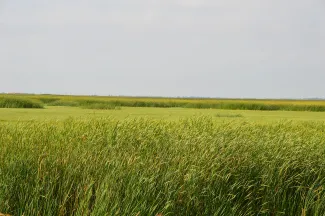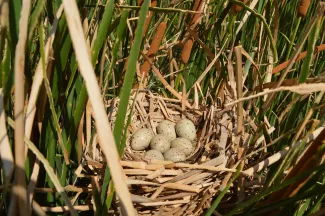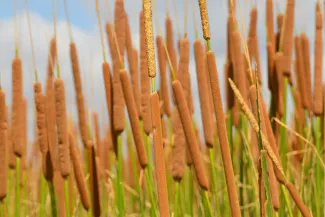Wetlands wouldn’t be complete without cattails. They not only add walls of rich gold and green color to the landscape, but also serve as important habitat for a variety of birds and other wildlife.
Perhaps the most universal of wetland vegetation, cattails are a staple at Hackberry Flat Wildlife Management Area near Frederick, Oklahoma. The area is just one of 30 managed by the Oklahoma Department of Wildlife Conservation as a Wetland Development Unit. Seasonally flooded, these WDUs provide habitat and refuge for a number of waterfowl and migratory bird species.

When the Wildlife Department started managing Hackberry Flat’s rich soils as the wetland it naturally was, the native plant community had been converted to wheat, cotton and other agricultural crops. “One of the things we didn’t have twenty years ago was a visual barrier,” said Kelvin Schoonover, wildlife biologist charged with managing Hackberry Flat WMA. “The cattails have since returned and now give the concealment and areas of shade many birds like.”
“A lot of Hackberry’s bird life use the cattails,” said Schoonover. “Our king rails, American bitterns, and least bitterns are rarely spotted away from cover. Several other species like the white-faced ibis, common moorhen, and especially red-winged blackbirds will also use the plants for nesting.”

But Schoonover knows that too much of a good thing can reduce a wetland’s overall wildlife diversity. How many is too many? For Schoonover, the balance tips when more than half of the wetland’s vegetation is cattails.
“Fifty percent cattails would be on the maximum end, I think.”
While narrowleaf cattails are native to Oklahoma, they are also aggressive and can quickly dominate the plant community.
“Cattails grow in clumps or blocks. When the blocks get too big and start to take over, there’s not a lot of room left for annual food-producing plants to grow,” Schoonover said. “You won’t have a lot of the smartweeds, toothcup, or barnyardgrasses that feed wildlife.”
To maintain the balance between the shelter-providing plants and the food-producing low-growing annuals, Schoonover and technician Bret Umber have been combating the cattails on multiple fronts.
“Water manipulation is a major cattail management tool in other parts of the United States, but it’s not an option for us,” said Schoonover. “We simply don’t have the water to flood the units deep enough to drown the cattail seeds,” Schoonover said. Hackberry Flat is prone to seasonal drought, and is recovering from the extreme drought of 2011-2015. “Since we aren’t able to hold enough water to manage the cattails, we have to use other management techniques.”
Disking dry units is one of these other methods, and is a popular management tool that also encourages sunflower germination. “Disking some of the dry units that had dense cover kills two birds with one stone, so to speak,” said Schoonover. “We can manage the amount of cattails that come up next year and promote sunflowers for more upland birds this fall.”
The U.S. Fish and Wildlife Service estimates a single seed head can contain as many as 250,000 seeds and that the seeds can remain viable in the seed bank for as many as 100 years. This means a single treatment will not suffice.

When disking won’t keep the cattails at bay, Schoonover and Umber turn to an even more direct management tool – herbicide. “We started spraying the edges of the thickest cattail clumps last year with an herbicide specifically labeled for wetland application,” said Schoonover.
As Schoonover and Umber monitor the treated areas, they’ve noticed a positive change. “We’re already seeing the desired shift – where dense stands of cattails are giving way to more food-producing plants,” said Schoonover.
“Our goal isn’t to get rid of the cattails, but to maintain a balance,” said Schoonover. “I’ve come to learn Hackberry is better with cattails than without.”
Get more tips for managing cattails from the U.S. Fish and Wildlife Service.